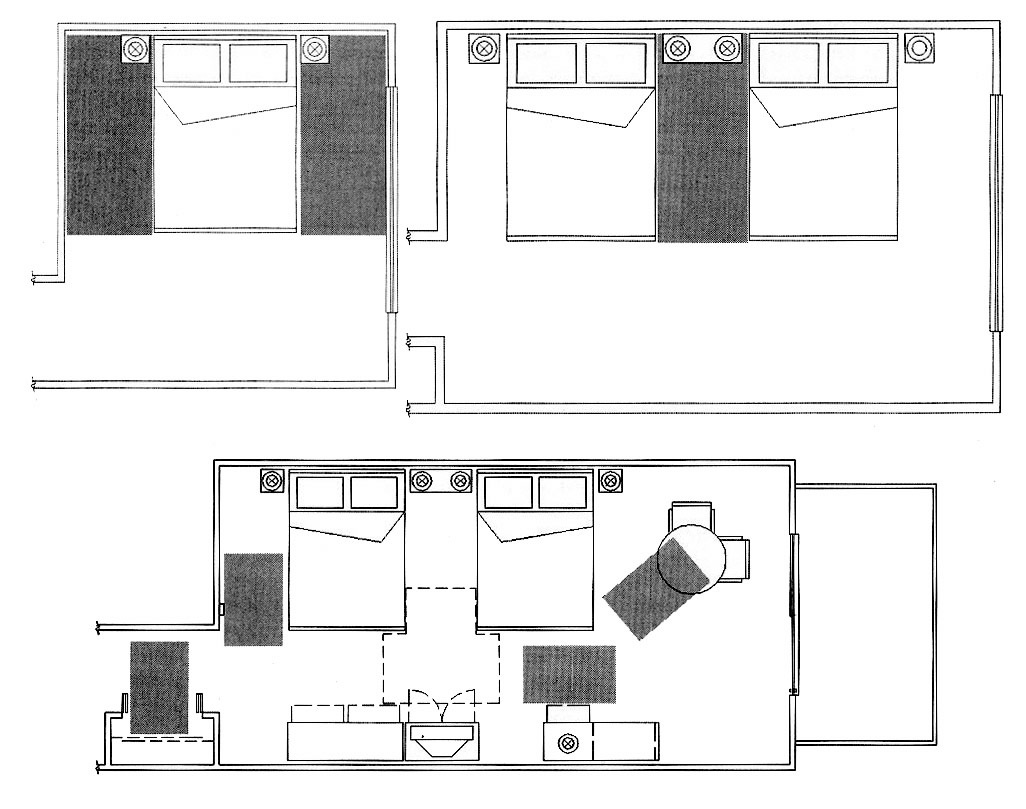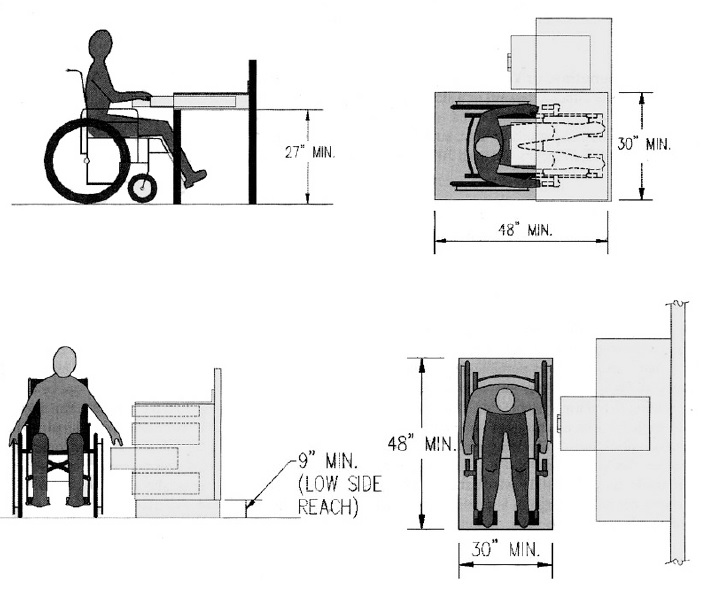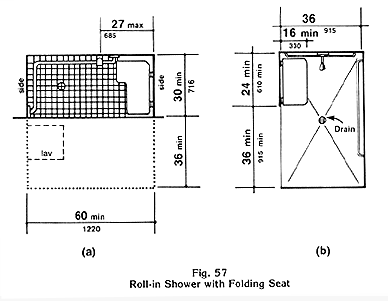Accessible Transient Lodging [9]
Section 9 covers a range of facilities that provide sleeping accommodations but that are not used as permanent residences. Examples noted in the section (hotels, motels, resorts, dormitories, homeless shelters, and halfway houses) are meant to be illustrative and do not represent all types of lodging used on a transient basis.
In the case of the private sector, other types of residential facilities, such as apartment buildings, are not subject to the ADA (except for places of public accommodations within them, such as rental or sales offices). Note that distinctions made for purposes of ADA coverage do not coincide with building code classifications of "residential" occupancies. The Department of Justice provides technical assistance and guidance concerning the classification of "transient lodging." Housing constructed or altered by or on behalf of state or local governments is required to be accessible under the ADA (title II). Access to housing in either the public or private sector is also required by the Fair Housing Amendments Act of 1988.
General [9.1.1]
ADAAG applies to all public and common use spaces, such as hallways, corridors, and lobbies. ADAAG requirements include specifications for protruding objects in 4.4 and for signage in 4.30. Wall-mounted objects, such as light fixtures, must be selected and mounted so they do not pose a hazard to people with vision impairments. Objects with leading edges above 27 inches and below 80 inches above the floor cannot project more than 4 inches unless there is a tactile cane detectable cue below the object. Where room numbers are provided, they must be raised and Brailled and located on the wall at the latch-sides of doors for safety and uniformity. (Redundant room numbers and additional information not required to be tactile can be placed on the face of doors).
Minimum Number [9.1.2 and 9.1.3]
The number of accessible rooms required is based on the total number of rooms provided. Dispersion of accessible rooms among different classes (based on size, cost, amenities, etc.) is necessary. Rooms with combination roll-in/transfer showers are required in transient lodging facilities with more than 50 rooms. The number of rooms with this type of shower must be added to the basic number of accessible rooms permitted to have an accessible tub or shower. Accommodations for people with hearing impairments are required in a portion of guest rooms, including all those that provide access for people with mobility impairments.
For example, a transient lodging facility with 100 guest rooms must have at least 5 accessible rooms, 1 of which provides a combination roll-in/ transfer shower. These rooms must also provide visual appliances for people with hearing impairments. In addition, at least 4 rooms must be equipped with visual appliances for people with hearing impairments; these rooms are not required to be wheelchair accessible.
| NOTE *minimum door clearance required in all sleeping rooms and suites | ||
| FACILITY TOTAL | VISUAL APPLIANCES ONLY Total |
MOBILITY ACCESS & VISUAL APPLIANCES Total (portion of total with roll in showers) |
| 1‒25* | 1 | 1 |
| 26‒50 | 2 | 2 |
| 51‒75 | 3 | 4 (1) |
| 76‒100 | 4 | 5 (1) |
| 101‒150 | 5 | 7 (2) |
| 151‒200 | 6 | 8 (2) |
| 201‒300 | 7 | 10 (3) |
| 301‒400 | 8 | 12 (4) |
| 401‒500 | 9 | 14 (5**) |
| 501‒1000 | 2% of total | 2% of total (**) |
| Over 1000 | *** | ***(**) |
| *EXEMPT: Facilities with 5 or less rooms for rent also used by the proprietor as a residence, but that do not serve as a homeless shelter, halfway house, transient group home, or other social service establishment. ** 4 + 1 for each 100 over 400 *** 20 + 1 for each 100 over 1000 |
||
Classes of Sleeping Accommodations [9.1.4]
Accessible sleeping rooms and suites must be dispersed among the various classes of sleeping accommodations available according to factors such as room size, cost, amenities provided, and the number of beds provided. The objective of dispersion is to give people with disabilities the same range of options that others have in staying at a place of lodging. However, where the different classes or types of sleeping accommodations is greater than the minimum number of rooms required to be accessible by the table, this does not mandate an increase in the number of accessible rooms that must be provided. In this case, operational practices may compensate. For example, if a person requests an accessible room with one bed, but the only accessible room is one with two beds (usually let at a higher rate), leasing the larger room at the lower rate can satisfy the requirement for a choice of room prices.
Alterations to Accessible Units, Sleeping Rooms, and Suites [9.1.5]
The minimum number of guest rooms required to be accessible in an alteration is based on the total number of guest rooms altered. This is required for all future room alterations until the total number of each required to be accessible for the facility overall is met. Recommendation: While the minimum number is based on the total number of sleeping rooms altered, it is recommended that the number be based on the total number of sleeping rooms provided where the intended scope of work allows the opportunity to do so.
Bedside Clearance [9.2.2(1)]
Where one bed is provided in a room, maneuvering space at least 36 inches wide is required on both sides of the bed. If two beds are provided, this maneuvering space is required only between the beds. Note that the requirement for an accessible route to accessible elements and spaces may result in a 36 inch clearance on the other side of double beds nonetheless.

Clear floor space is required at accessible controls and elements (e.g., thermostats), storage facilities (e.g., closets), and should be provided at non-fixed furnishings (e.g., dressers, tables). An accessible route must connect with the clear floor space. Turning space can overlap required clear floor space, including bedside clearances.
Accessible Route [9.2.2(2)]
An accessible route at least 36 inches wide must be provided to all accessible elements, including phones and thermostats, provided for use by room occupants, fixed or built-in storage facilities required to be accessible (closets, drawers, cabinets), and other spaces required to be accessible (living area, dining area, at least one bathroom and sleeping area, and patios, terraces or balconies, and carports, garages or parking spaces). Recommendation: ADAAG does not address furniture, but it is recommended that where dressers are provided, clear floor space should be provided so that people using wheelchairs can access dresser drawers.
Doors [9.2.2(3), 9.4]
Compliance with 4.13 is required for all doors and doorways designed to allow passage into and within all sleeping suites or other units required to be accessible. Recommendation: An additional peephole in the door for people who use wheelchairs or who are of short stature is not required but may be desirable especially if one offering a wide angle view of the hallway or exterior is used.
Because of the social interaction and visitation that often occurs in lodging facilities, an accessible door clear opening width (32 inches minimum) is required to and within all sleeping rooms and suites, even to those rooms not required to be accessible. This applies to all doors, including bathroom doors, that allow full passage.
Storage [9.2.2(4)]
At least one of each type of fixed or built-in storage facility (cabinets, shelves, closets, drawers) provided in accessible spaces must be accessible as specified in 4.25. "Type" refers to the design of the element (shelving, cabinets, closets) as well as the intended use (coat closets and supply closets). Additional storage elements of the same type are not required to comply.
Clear floor space for either a forward or side approach is allowed. However, since people who use wheelchairs may not be able to reach much beyond the toes, a forward reach is generally limited to those storage elements providing knee and toe clearances. Otherwise, space should be provided for side approaches.

Controls [9.2.2(5)]
All controls in accessible units, sleeping rooms, and suites must comply with 4.27, which provides specifications for clear floor space, height of operable controls, and operation (see pages 96 and 97). These requirements apply primarily to those controls and operating mechanisms intended for use by patrons; those used only by employees and facility operators for purposes of maintenance or repair and similar purposes (electrical outlets for cleaning equipment, refrigerators, and clocks, etc.) are not required to comply.
Accessible Spaces [9.2.2(6)]
Where provided in accessible units, sleeping rooms, or suites, the following spaces are required to be accessible and be on an accessible route: living areas, dining areas, at least one sleeping area, patios, terraces, or balconies, bathrooms, and carports, garages, or parking spaces.
Bathrooms
Accessible bathrooms must provide an accessible water closet, accessible lavatory, and accessible shower or tub. If only half baths are provided, accessible fixtures are required in at least the one half bath required to be accessible. ADAAG allows provision of either tubs or showers in most accessible rooms. Some rooms in larger facilities must have a combination roll-in/ transfer shower. ADAAG covers several types of shower stall designs: roll-in, transfer, and, in hotels, a combination of the two. Typically a shower chair, a mobility aid more suitable for bathing than standard wheelchairs, is used with roll-in showers. Roll-in showers are most practical where shower chairs can be made readily available or where people may stay for extended periods (dormitories, dwelling units). The required folding seat in combination roll-in/ transfer showers offers greater flexibility by allowing transfer as well, particularly for people traveling without a shower chair. Two types of design for this combination shower are provided in ADAAG (Figure 57).

Kitchens, Kitchenettes, or Wet Bars [9.2.2(7)]
Clear floor space for either a forward or a side approach is permitted for cabinets, counters, sinks, and appliances. A forward approach to sinks (with knee and toe clearances below) is recommended for sinks that may be used more regularly or for extended periods of time, such as a kitchen in apartment-style dormitories. Counter tops and sinks may be no higher than 34 inches. At least 50% of refrigerator and cabinet shelf space must be within the reach ranges specified in 4.2.5 or 4.2.6.
Accommodations for Persons with Hearing Impairments [9.2.2(8)]
Accessible rooms or suites must also provide accommodations for people with hearing impairments (visual alarms and notification devices, volume controls on permanently installed telephones, etc.). This is required in order to accommodate a person (or couple or family) who needs both types of access. Additional portions of rooms or suites are required to provide accommodations only for persons with hearing impairments.
Visual Alarms, Notification Devices and Telephones [9.3] Auxiliary Alarms
A portion of sleeping units in transient lodging facilities must have a visual alarm connected to the building alarm system or have an outlet for a portable device. Portable devices must be capable of being triggered by the building emergency alarm system. Appliances connected to the building system, where permitted by code, can be monitored by the building fire alarm system. Portable units have to be activated by a signal from the central alarm control system, transmitted to a receiver plugged into an electrical outlet. Note that there are operational considerations in making portable appliances available on an as-needed basis. Where portable devices are used, it is important that the appliance be checked to make sure it is functioning properly, and that correct and appropriate connections and placement are made, a responsibility which should not be left solely to guests or tenants who need the device. Because guest room sizes are not large, it is required only that the signal, which is intended to alert persons who are awake, be visible in all areas of the room or unit.
Visual Notification Devices
Care must be taken that notification devices intended to signal a door knock or bell are separately wired. Like auxiliary alarms, these devices can be portable and made available as needed. In this case, ADAAG requires appropriate outlets and wiring.
Phones
Permanently installed telephones must be equipped with a volume control. An accessible electrical outlet within 4 feet of a phone connection is required to facilitate use of a portable text telephone (or TTY). (Facility operators are responsible for making portable TTYs available under ADA requirements that call for the provision of "auxiliary aids.") TTYs at hotel front desks will allow guests using TTYs in their room to access in-house services.
Social Service Establishments [9.5]
Section 9.5 provides requirements specific to halfway houses, homeless shelters, and group homes because they are a form of transient lodging and often designed for communal living. Where appropriate, scoping for accessible rooms can be applied to the number of beds. Alterations provisions recognize unique problems that may arise when shelters and similar facilities are placed in existing facilities designed for other purposes.

User Comments/Questions
Add Comment/Question